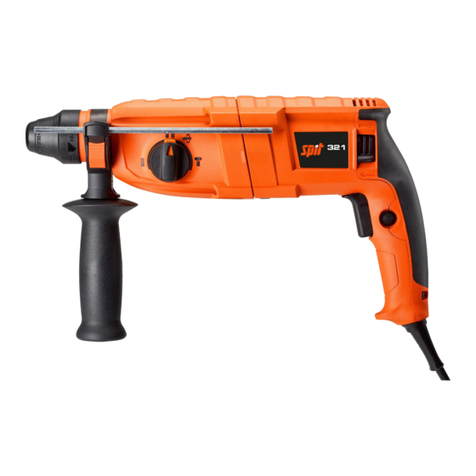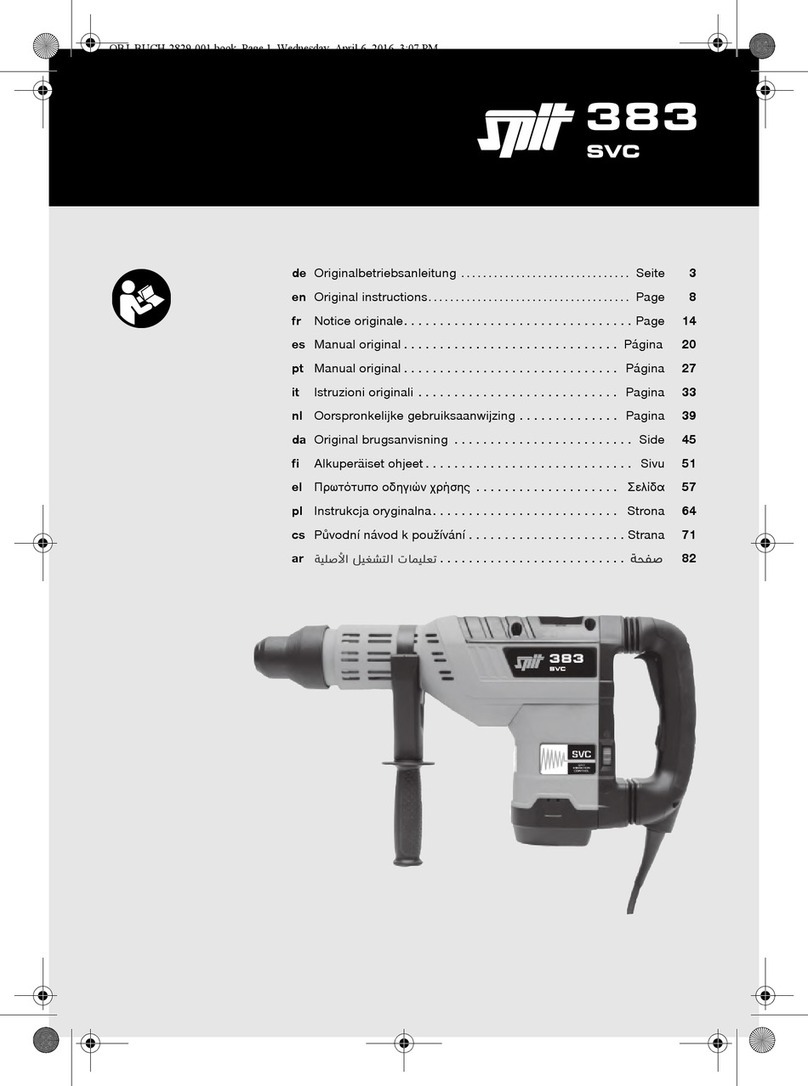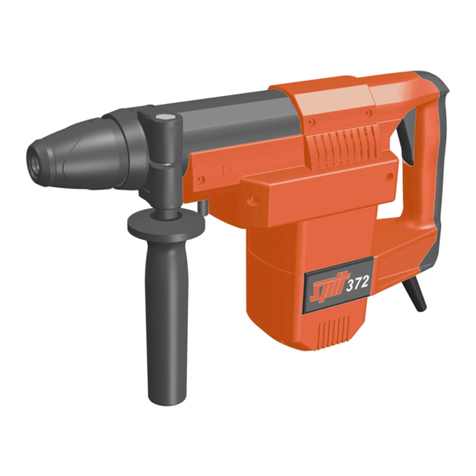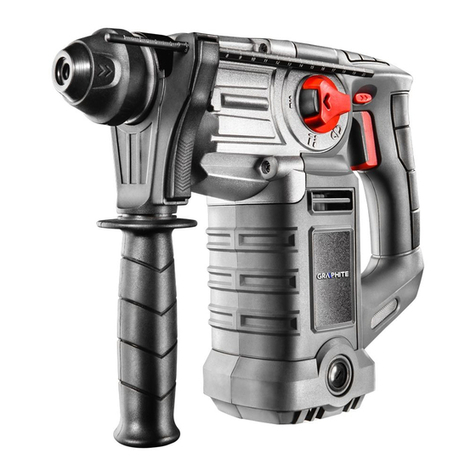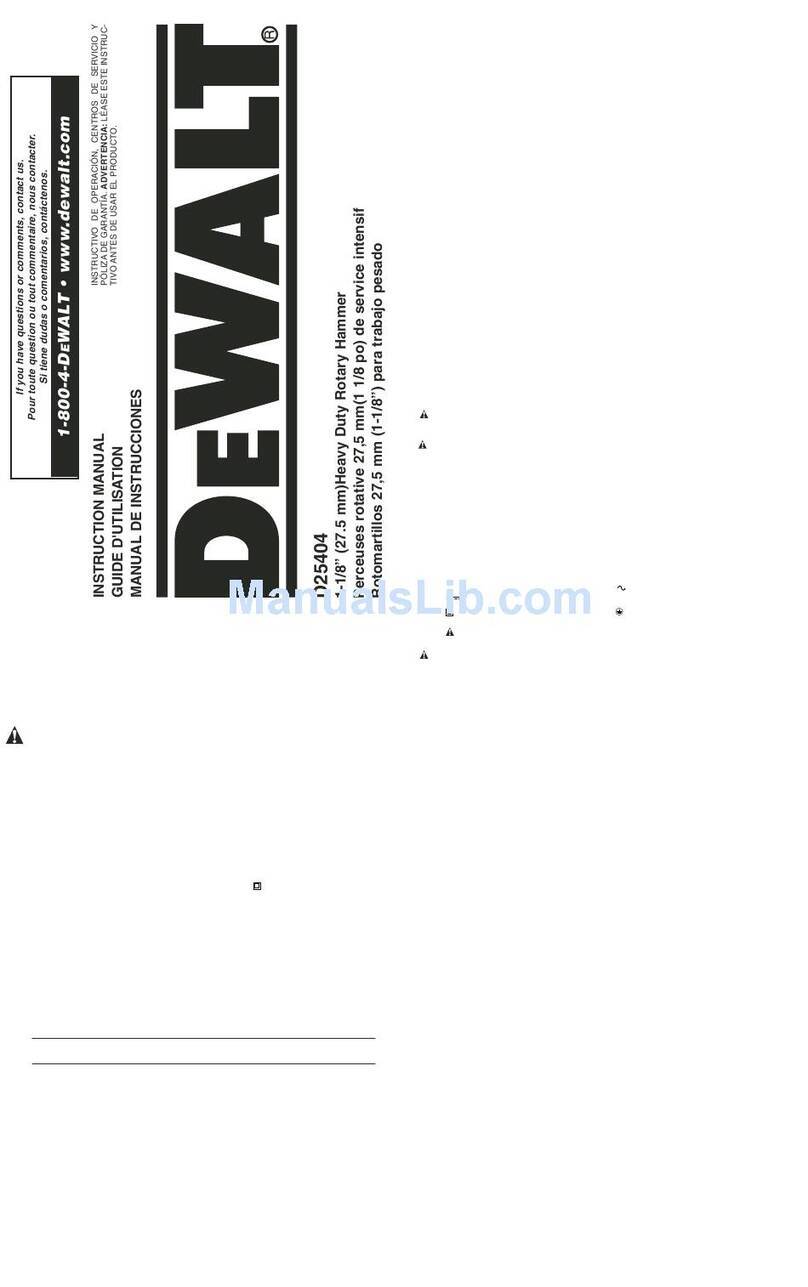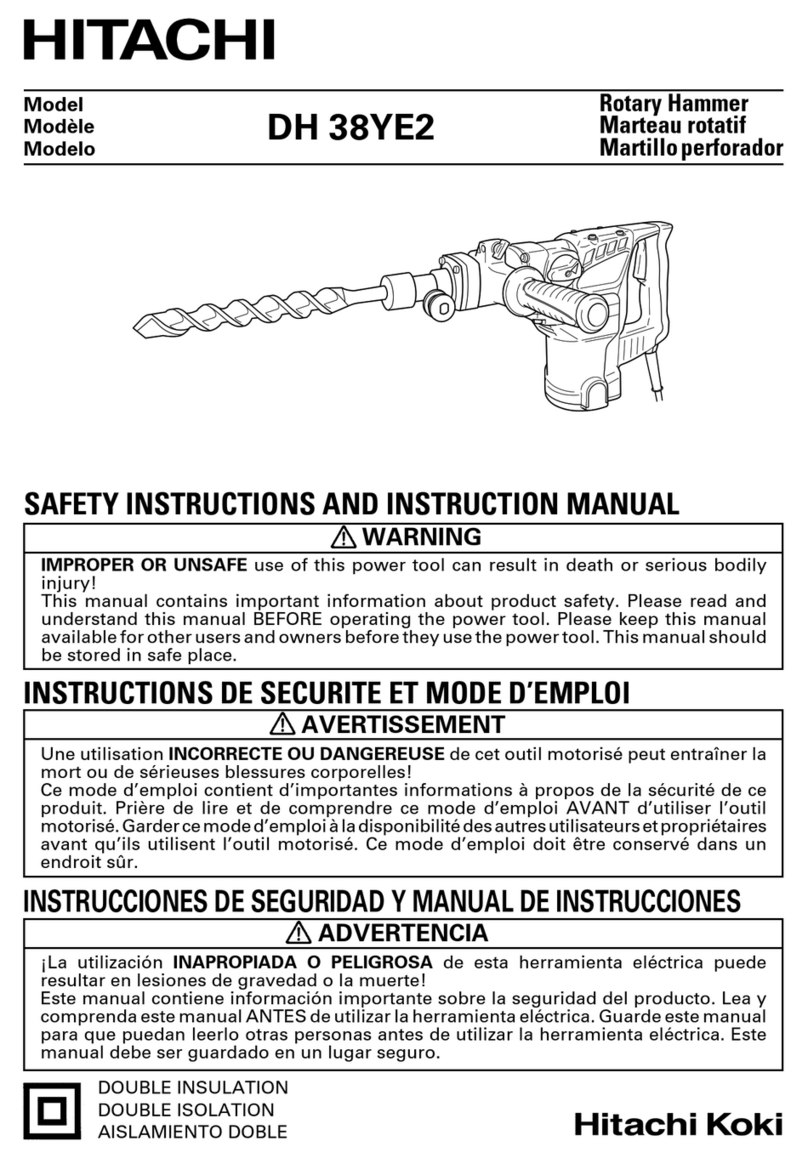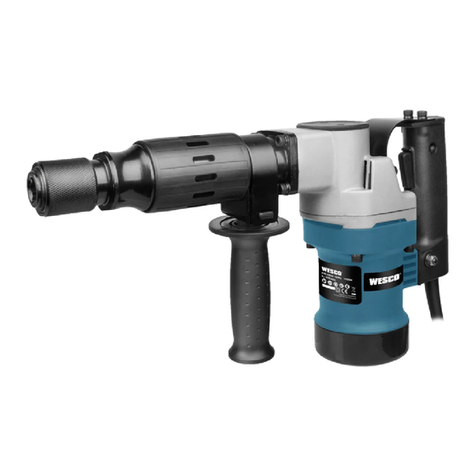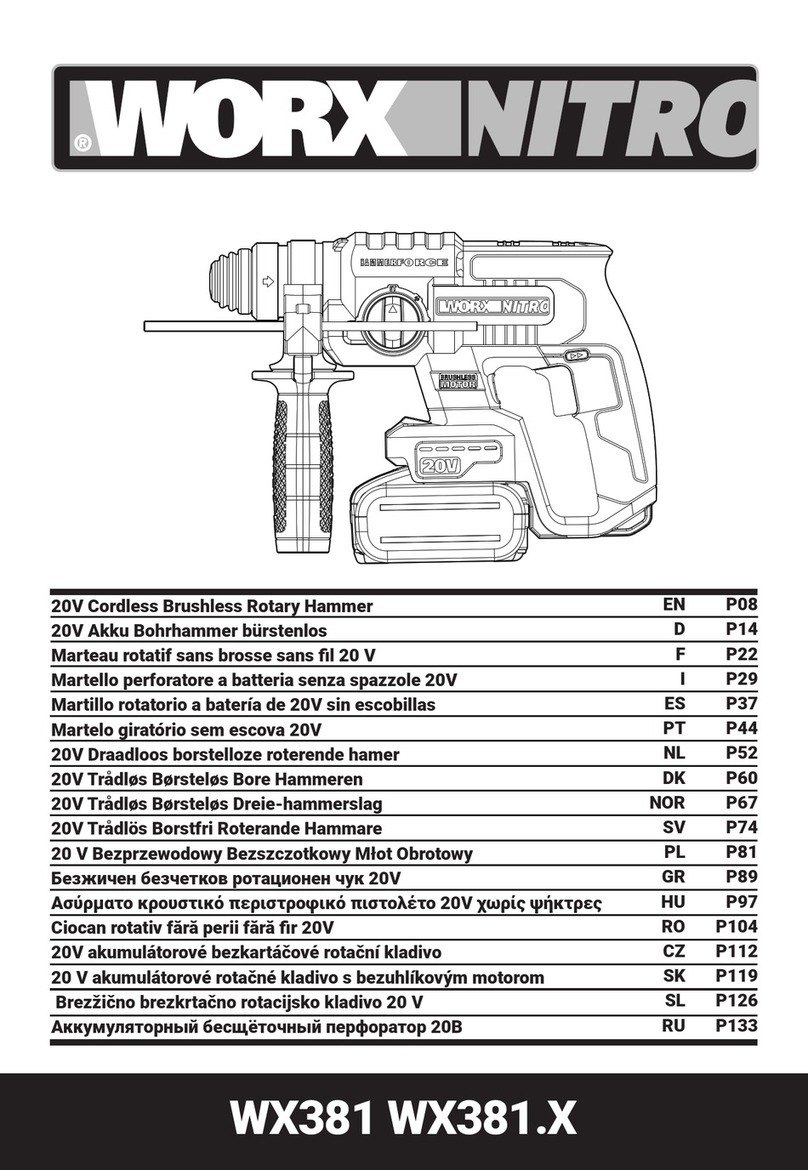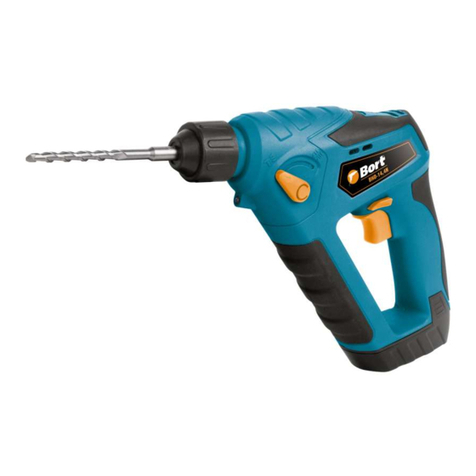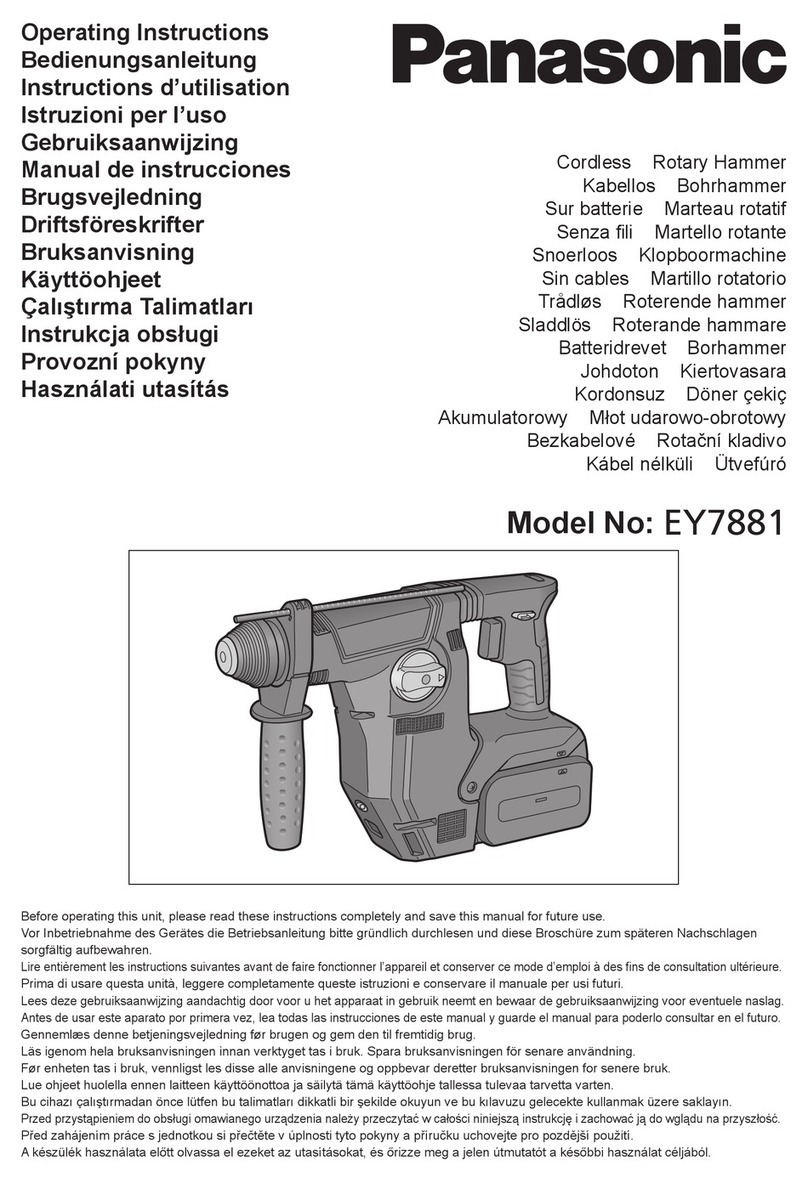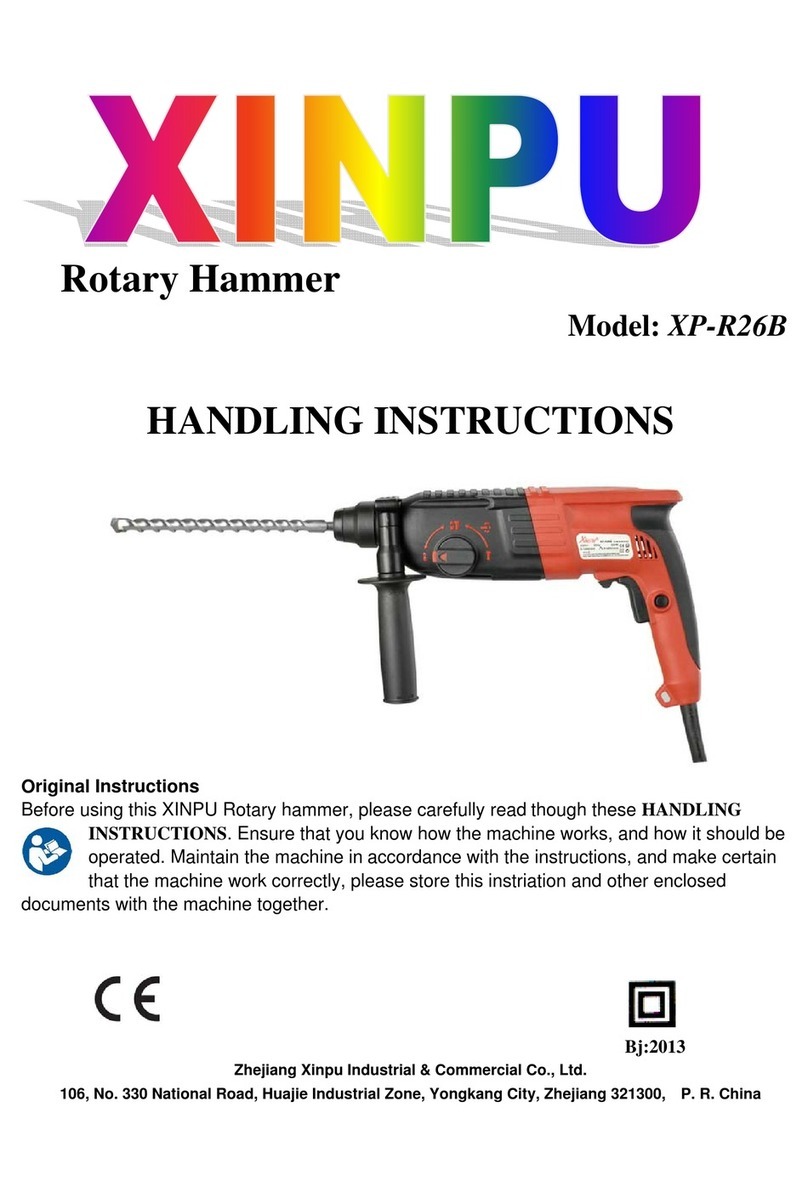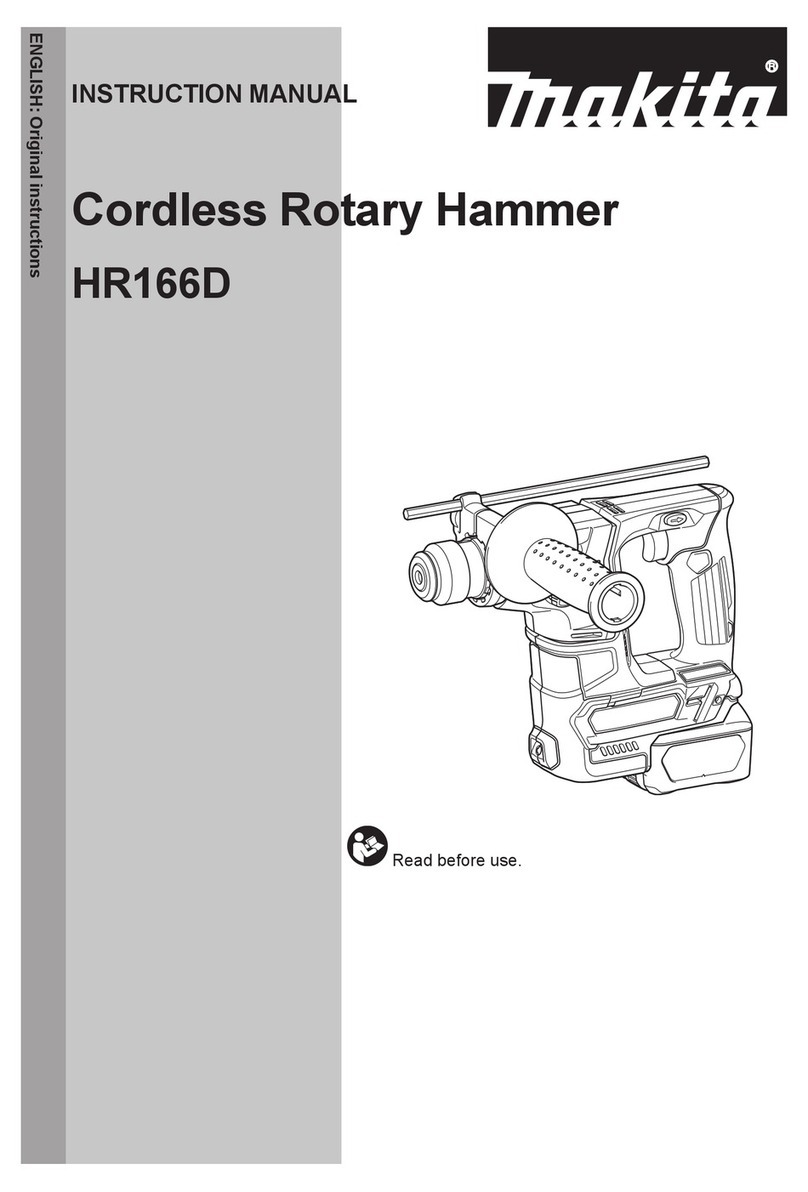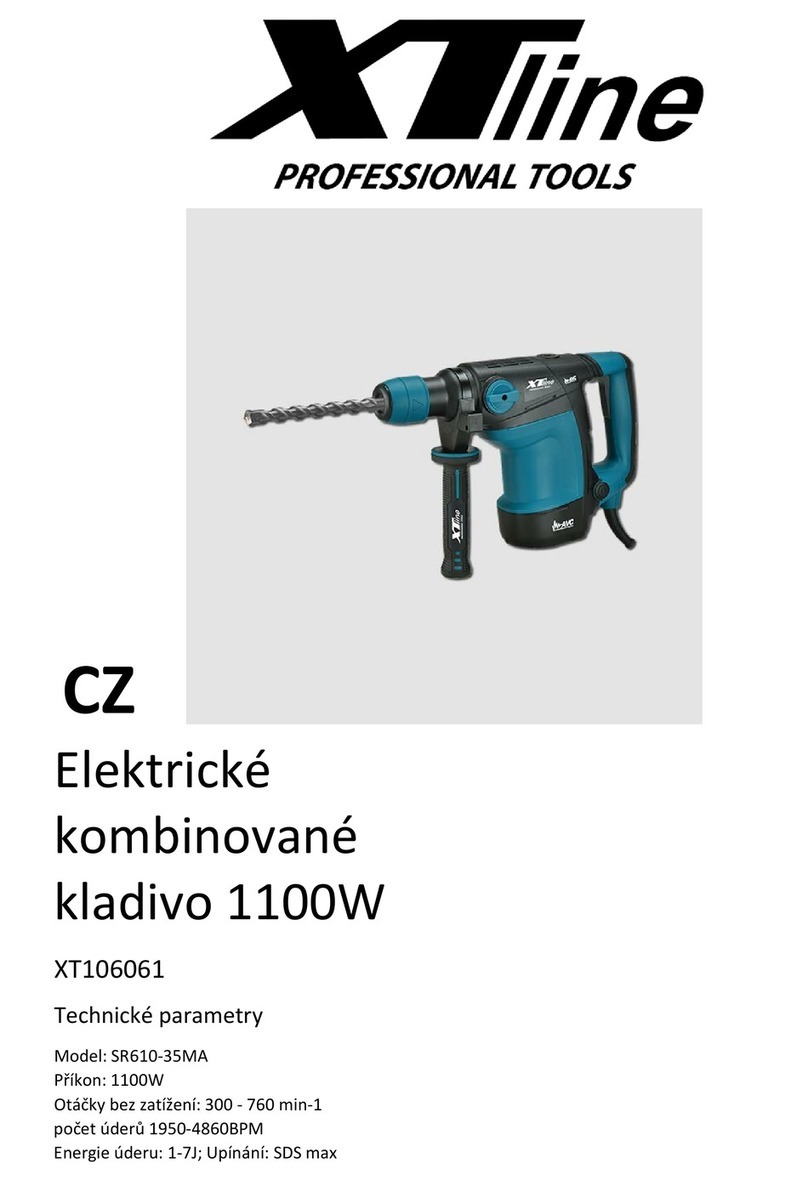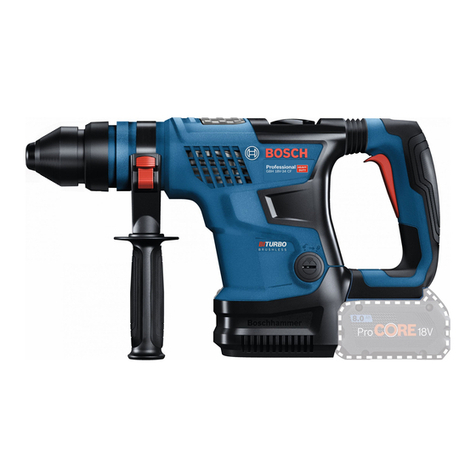SPIT 17P SD Guide

Operator’s manual and
maintenance instructions 1
Notice d’emploi et
d’entretien 11
Gebruiksaanwijzing en
onderhoudsinstructies 21
Bedienungs- und
Wartungsanleitungen 32
Instrucciones del manual de usuario
y de mantenimiento 43
Manuale d’uso
e manutenzione 54
Manual de utilização
e manutenção 65

1. Spindle - outside M41 /
inside 1/2” BSP
2. Soft impact on/off selector
3. Speed selector lock
4. Speed selector
5. Spirit level
6. Back handle
7. Switch
8. Switch lock
9. Power cable 4m
10. Gear box
11. Integrated dust exhaust
12. Front handle Ø 60 mm
13. Vacuum cleaner connection
14. Locking screw
1. Mandrin - extérieur M41 /
intérieur 1/2” BSP
2. Sélecteur impact doux on/off
3. Verrouillage du sélecteur de vitesse
4. Sélecteur de vitesse
5. Niveau à bulle
6. Poignée arrière
7. Commutateur
8. Verrouillage du commutateur
9. Câble d’alimentation 4 m
10. Boitier d’engrenage
11. Système intégré pour l’aspiration
des poussières
12. Poignée avant Ø 60 mm
13. Raccord d’aspiration
14. Vis de blocage poignée
1
2
3
4
10
11
12
13
14
12

1. Mandrin - extérieur M41 /
intérieur 1/2” BSP
2. Sélecteur impact doux on/off
3. Verrouillage du sélecteur de vitesse
4. Sélecteur de vitesse
5. Niveau à bulle
6. Poignée arrière
7. Commutateur
8. Verrouillage du commutateur
9. Câble d’alimentation 4 m
10. Boitier d’engrenage
11. Système intégré pour l’aspiration
des poussières
12. Poignée avant Ø 60 mm
13. Raccord d’aspiration
14. Vis de blocage poignée
1. As - buiten M41 /
binnen 1/2” BSP
2. Aan/uit selector voor impact
3. Vergrendeling schakelknop
4. Versnelling schakelknop
5. Waterpas
6. Achterhandvat
7. Schakelaar
8. Vergrendeling schakelaar
9. Kabel 4 m
10. Versnellingsbak
11. Geïntegreerde stofafzuiging
12. Voorhandvat Ø 60 mm
13. Aansluiting stofzuiger
14. Vergrendelknop handvat
1. Bohrspindel M41 außen /
½” innen
2. Schlag Ein-/Ausschalter
3. Auslöser Gangwahlschalter
4. Gangwahlschalter
5. Niveau
6. Handgriff
7. Ein-/Ausschalter
8. Feststelltaste für Ein-/Ausschalter
9. Kabel 4 m
10. Getriebegehäuse
11. Integrierte Staubabsaugung
12. Zusatzgriff Ø 60 mm
13. Absaugschlauch
14. Klemmschraube des Zusatzgriff
5
6
7
8
9
10
8

1. Bohrspindel M41 außen /
½” innen
2. Schlag Ein-/Ausschalter
3. Auslöser Gangwahlschalter
4. Gangwahlschalter
5. Niveau
6. Handgriff
7. Ein-/Ausschalter
8. Feststelltaste für Ein-/Ausschalter
9. Kabel 4 m
10. Getriebegehäuse
11. Integrierte Staubabsaugung
12. Zusatzgriff Ø 60 mm
13. Absaugschlauch
14. Klemmschraube des Zusatzgriff
1. Árvore porta-brocas M41 externamente
/ ½” internamente
2. Seletor de impacto
3. Tecladexaçãoparaoselectorde
marchas
4. Seletor de marchas
5. Nível
6. Punho
7. Interruptor de ligar-desligar
8. Tecladexaçãoparaointerruptorde
ligardesligar
9. Cabo 4 m
10. Caixa de velocidades
11. Aspiração de pó integrado
12. Punho adicional dia 60 mm
13. Conexão de vácuo
14.Tecladexaçãoparapunhoadicional
1. Husillo de taladrar M41 externamente /
½” internamente
2. Selector de impacto
3. Botóndejaciónparalapalancade
cambios
4. Selector de marchas
5. Piloto
6. Empuñadura
7. Interruptor de conexión/desconexión
8. Tecla de enclavamiento del interruptor
de conexión/desconexión
9. Cable 4 m
10. Caja de cambios
11. Aspiración de polvo integrada
12. Empuñadura adicional dia 60 mm
13. Conexión de vacío
14.Botóndejaciónparalaempuñadura
adicional
1. Alberinolettatolettatura
esternaM41/lettaturainterna½”
2. Impatti selettore on / off
3. Serratura di commutatore di marcia
4. Commutatore di marcia
5. Spia di controllo
6. Impugnatura
7. Interruttore di avvio / arresto
8. Tasto di bloccaggio per interruttore
avvio / arresto
9. Cavo 4 m
10. Scatola del cambio
11. Estrazione della polvere integrato
12. Impugnatura supplementare
Ø 60 mm
13. Tubo di aspirazione
14. Tasto di bloccaggio di impugnatura
supplementare


1
SYMBOLS USED IN THIS MANUAL
Warning notices:
Warning of general danger
Warning of dangerous voltage
Warning of hot surface
Danger of being crushed
Class II tool
During work you should wear goggles, ear protectors, protective gloves, and
sturdy work clothes!!
Read these instructions
Use ear protection
Wear safety goggles
Wear helmet
Use protective gloves
Wear protective boots
Wear dust mask
Do not dispose of electric tools, accessories and packaging together with household
waste material
V .......................volt
A .......................ampere
Hz .....................hertz
W.......................watt
~........................alternating current
n0.......................no load speed
min_1 ..................revolutions per minute

2
SAFETY INSTRUCTIONS
General Power Tool Safety Warnings
Read all safety warnings and all instructions.
Failuretofollowthewarningsandinstructionsmayresultinelectricshock,reand/orserious
injury.
Save all warnings and instructions for future reference.
The term “power tool” in the warnings refers to your mains-operated (corded) power tool or
battery-operated (cordless) power tool.
1) Work area safety
a) Keep work area clean and well lit.
Cluttered or dark areas invite accidents.
b) Do not operate power tools in explosive atmospheres, such as in the presence of
ammableliquids,gasesordust.
Power tools create sparks which may ignite the dust or fumes.
c) Keep children and bystanders away while operating a power tool.
Distractions can cause you to lose control.
2) Electrical safety
a) Power tool plugs must match the outlet.
Never modify the plug in any way. Do not use any adapter plugs with earthed (grounded)
powertools.Unmodiedplugsandmatchingoutletswillreduceriskofelectricshock.
b) Avoid body contact with earthed or grounded surfaces, such as pipes, radiators, ranges
and refrigerators. There is an increased risk of electric shock if your body is earthed or
grounded.
c) Do not expose power tools to rain or wet conditions.
Water entering a power tool will increase the risk of electric shock.
d) Do not abuse the cord. Never use the cord for carrying, pulling or unplugging the power
tool. Keep cord away from heat, oil, sharp edges and moving parts.
Damaged or entangled cords increase the risk of electric shock.
e) When operating a power tool outdoors, use an extension cord suitable for outdoor use.
Use of a cord suitable for outdoor use reduces the risk of electric shock.
f) If operating a power tool in a damp location is unavoidable, use a residual current device
(PRCD) protected supply.
Use of an PRCD reduces the risk of electric shock.
3) Personal safety
a) Stay alert, watch what you are doing and use common sense when operating a power
tool.Donotuseapowertoolwhileyouaretiredorundertheinuenceofdrugs,alcoholor
medication.
A moment of inattention while operating power tools may result in serious personal injury.
b) Usepersonalprotectiveequipment.Alwaysweareyeprotection.
Protectiveequipmentsuchasdustmask,non-skidsafetyshoes,hardhat,orhearing
protection used for appropriate conditions will reduce personal injuries.
c) Prevent unintentional starting. Ensure the switch is in the off-position before connecting to
power source and/or battery pack, picking up or carrying the tool.
Carryingpowertoolswithyourngerontheswitchorenergizingpowertoolsthathavethe
switch on invites accidents.
d) Remove any adjusting key or wrench before turning the power tool on.
A wrench or a key left attached to a rotating part of the power tool may result in personal
injury.
e) Do not overreach. Keep proper footing and balance at all times. This enables better control
of the power tool in unexpected situations.

3
f) Dress properly. Do not wear loose clothing or jewelry. Keep your hair, clothing and gloves away
from moving parts.
Loose clothes, jewelry or long hair can be caught in moving parts.
g) If devices are provided for the connection of dust extraction and collection facilities, ensure these
are connected and properly used.
Use of dust collection can reduce dust-related hazards.
4) Power tool use and care
a) Do not force the power tool. Use the correct power tool for your application.
The correct power tool will do the job better and safer at the rate for which it was designed.
b) Do not use the power tool if the switch does not turn it on and off.
Any power tool that cannot be controlled with the switch is dangerous and must be repaired.
c) Disconnect the plug from the power source and/or the battery pack from the power tool before
making any adjustments, changing accessories, or storing power tools.
Such preventive safety measures reduce the risk of starting the power tool accidentally.
d) Store idle power tools out of the reach of children and do not allow persons unfamiliar with the
power tool or these instructions to operate the power tool.
Power tools are dangerous in the hands of untrained users.
e) Maintain power tools. Check for misalignment or binding of moving parts, breakage of parts and
any other condition that may affect the power tool’s operation. If damaged, have the power tool
repaired before use. Many accidents are caused by poorly maintained power tools.
f) Keep cutting tools sharp and clean.
Properly maintained cutting tools with sharp cutting edges are less likely to bind and are easier
to control.
g) Use the power tool, accessories and tool bits etc. in accordance with these instructions, taking
into account the working conditions and the work to be performed.
Use of the power tool for operations different from those intended could result in a hazardous
situation.
5) Service
a) Haveyourpowertoolservicedbyaqualiedrepairpersonusingonlyidenticalreplacementparts.
This will ensure that the safety of the power tool is maintained.
SAFETY WARNINGS FOR DIAMOND DRILLS
General Information for Diamond Drills
Hold power tool by insulated gripping surfaces, when performing an operation where the cutting
accessory may contact hidden wiring or its own cord.
Cutting accessory contacting a “live” wire may make exposed metal parts of the power tool “live” and
could give the operator an electric shock.
Use suitable detectors to determine if utility lines are hidden in the work area or call the local utility
company for assistance.
Contactwithelectriclinescanleadtoreandelectricshock.Damagingagaslinecanleadtoexplosion.
Penetrating a water line causes property damage or may cause an electric shock.
The safety and operating instructions for the drill stand and the accessories being used are to be strictly
observed!
Store the machine in a safe manner when not being used. The storage location must be dry and lockable.
This prevents the machine from storage damage, and from being operated by untrained persons.
Keep handles dry, clean, and free from oil and grease.
Greasy, oily handles are slippery causing loss of control.
Never use the machine with a damaged cable. Do not touch the damaged cable and pull the mains plug
when the cable is damaged while working.
Damaged cables increase the risk of an electric shock.

4
f) Dress properly. Do not wear loose clothing or jewelry. Keep your hair, clothing and gloves away
from moving parts.
Loose clothes, jewelry or long hair can be caught in moving parts.
g) If devices are provided for the connection of dust extraction and collection facilities, ensure these
are connected and properly used.
Use of dust collection can reduce dust-related hazards.
4) Power tool use and care
a) Do not force the power tool. Use the correct power tool for your application.
The correct power tool will do the job better and safer at the rate for which it was designed.
b) Do not use the power tool if the switch does not turn it on and off.
Any power tool that cannot be controlled with the switch is dangerous and must be repaired.
c) Disconnect the plug from the power source and/or the battery pack from the power tool before
making any adjustments, changing accessories, or storing power tools.
Such preventive safety measures reduce the risk of starting the power tool accidentally.
d) Store idle power tools out of the reach of children and do not allow persons unfamiliar with the
power tool or these instructions to operate the power tool.
Power tools are dangerous in the hands of untrained users.
e) Maintain power tools. Check for misalignment or binding of moving parts, breakage of parts and
any other condition that may affect the power tool’s operation. If damaged, have the power tool
repaired before use. Many accidents are caused by poorly maintained power tools.
f) Keep cutting tools sharp and clean.
Properly maintained cutting tools with sharp cutting edges are less likely to bind and are easier
to control.
g) Use the power tool, accessories and tool bits etc. in accordance with these instructions, taking
into account the working conditions and the work to be performed.
Use of the power tool for operations different from those intended could result in a hazardous
situation.
5) Service
a) Haveyourpowertoolservicedbyaqualiedrepairpersonusingonlyidenticalreplacementparts.
This will ensure that the safety of the power tool is maintained.
SAFETY WARNINGS FOR DIAMOND DRILLS
General Information for Diamond Drills
Hold power tool by insulated gripping surfaces, when performing an operation where the cutting
accessory may contact hidden wiring or its own cord.
Cutting accessory contacting a “live” wire may make exposed metal parts of the power tool “live” and
could give the operator an electric shock.
Use suitable detectors to determine if utility lines are hidden in the work area or call the local utility
company for assistance.
Contactwithelectriclinescanleadtoreandelectricshock.Damagingagaslinecanleadtoexplosion.
Penetrating a water line causes property damage or may cause an electric shock.
The safety and operating instructions for the drill stand and the accessories being used are to be strictly
observed!
Store the machine in a safe manner when not being used. The storage location must be dry and lockable.
This prevents the machine from storage damage, and from being operated by untrained persons.
Keep handles dry, clean, and free from oil and grease.
Greasy, oily handles are slippery causing loss of control.
Never use the machine with a damaged cable. Do not touch the damaged cable and pull the mains plug
when the cable is damaged while working.
Damaged cables increase the risk of an electric shock.
Check the cable regularly and have a damaged cable repaired only through an authorized cus-
tomer
service agent for SPIT power tools. Replace damaged extension cables.
This will ensure that the safety of the power tool is maintained.
Wear non-skid shoes.
This prevents injuries that can occur from slipping on smooth surfaces.
Use only original SPIT accessories.
Connect the machine to a mains supply with proper earth connection.
Socketoutletandextensioncablemustbeequippedwithanoperativeprotectiveconductor.
Iftheplugisnotsuitableforyoursocketoutlets,itshouldbecutoffandanappropriateplugtted
in its place by an authorized customer service agent. The replacement plug should have the same
fuse rating as the original plug. The severed plug must be disposed of to avoid a possible shock
hazard and should never be inserted into a mains socket elsewhere.
INSTRUCTIONS FOR OPERATION WITHOUT DRILL STAND
Use auxiliary handle(s), if supplied with the tool.
Loss of control can cause personal injury.
Always wait until the machine has come to a complete stop before placing it down.
The tool insert can jam and lead to loss of control over the power tool.
Whenworkingwiththemachine,alwaysholditrmlywithbothhandsandprovideforasecure
stance.
The power tool is guided more secure with both hands.
If the application tool should become blocked, switch the machine off. Loosen the application tool.
Before switching on the power tool, make sure that the application tool moves freely.
Whenswitchingonwithablockeddrillingtool,hightorquereactioncanoccur.
INSTRUCTIONS FOR OPERATION WITH DRILL STAND
Never leave the machine before it has come to a complete stop.
Cutting tools that are still running can cause injuries.
Hold the drill stand by the insulated gripping surfaces when performing operations where the ap-
plication tool could contact hidden wiring or its own power cord.
Contact with a “live” wire will also make exposed metal parts of the drill stand “live” and shock the
operator.
FUNCTIONAL DESCRIPTION
Read all safety warnings and all instructions.
Failuretofollowthewarningsandinstructionsmayresultinelectricshock,reand/or
serious injury.
While reading the operating instructions, unfold the graphics page for the machine and
leave it open.

5
TECHNICAL SPECIFICATIONS
Power 1800 W
Voltage 220-240 V
Frequency 50-60Hz
Current 7,8 A
Impactfrequency 1stspeed 28800bpm
2nd speed 57600 bpm
No load speed 2400 / 3600 min-1
Full load speed 1200 / 1980 min-1
Maximum drill potential Ø 181 mm
Connection M41 & 1/2”
Safety mechanism mechanical clutch
Thermal safety mechanism yes
Protection against excess pressure through an electronic system
Protective class II
Cable 4 m
Weight EPTA 5,51 kg
Measurements 500 x 210 x 115 mm
Hand grip yes
Noise and vibration
Measured sound values determined according to EN 60745-2-1
Typically the A-weighted noise levels of the product are:
Sound pressure level LpA 94 dB(A).
Sound power level LwA 105 dB(A).
Uncertainty K=3 dB.
Wear hearing protection!
Vibration total values (triax vector sum) determined according to EN 60745:
Vibration level: ah: 10,1 m/s² K= 1,5 m/s² (drilling without impact into concrete)
Vibration level: ah: 17,3 m/s² K= 1,5 m/s² (drilling with impact into concrete)
The vibration emission level given in this information sheet has been measured in
accordance with a standardized test given in EN 60745 and may be used to compare
one tool with another. It may be used for a preliminary assessment of exposure.
The declared vibration emission level represents the main applications of the tool.
However if the tool is used for different applications, with different accessories or poorly
maintained,thevibrationemissionmaydiffer.Thismaysignicantlyincreasethe
exposure level over the total working period. An estimation of the level of exposure to
vibration should also take into account the times when the tool is switched off or when it
isrunningbutnotactuallydoingthejob.Thismaysignicantlyreducetheexposure
level over the total working period. Identify additional safety measures to protect the
operator from the effects of vibration such as: maintain the tool and the accessories,
keep the hands warm, organization of work patterns.

6
Intended use
SD 17P: In conjunction with dry diamond core bits and an integrated extraction device,
the machine is intended for dry drilling in bricks, sandstone, aerated concrete and tiles.
All uses for other purposes are prohibited.
Thetoolisequippedwithaspiritlevelashelpforhorizontaldrilling,mechanicalclutch,
soft start, thermal protection, and overload protection.
Conrmation declaration
We declare under our sole responsibility that the product described under “Technical
Data” is in conformity with the following standards or standardization documents:
EN 60745 according to the provisions of the directives 2011/65/EU, 2004/108/EC,
2006/42/EC.
SPIT SAS
150, Route de Lyon
26500 Bourg-lès-Valence Cedex
France
Guy Jaillet Ruben Bernaert
Director Product Manager
Business Development & Innovation
FUNCTIONAL DESCRIPTION
Electrical connection
Prior to putting the tool into operation, check the mains voltage for conformity with the
requirementsofthetool’snameplate.
Voltage variations between + 6 % and – 10 % are permissible.
The tool includes a start-up speed limiter to prevent fast expulsion fuses from
unindented responding.
Onlyuseextensioncableswithasufcientcross-section.Across-sectionwhichistoo
small could cause a considerable drop in performance and an overheating of machine
and cable.
Recommended minimum cross sections and maximum cable lengths
Mains voltage 230 V
Cross section in mm21.5 2.5
Maximum cable length 50 m 80 m

7
ASSEMBLY
Mount the auxiliary handle clamp on to the gearbox neck. Position the side handle
perpendicular to the main handle. Use the lock screw to tighten the clamp.
LIST OF CONTENTS
SD 17P Diamond dry drill coring machine.
Side handle assembly
Vacuum adaptor
Wrench 46 mm
Wrench 38 mm
Wrench 24 mm
Operators and safety manual
OPERATING INSTRUCTIONS
Mounting the dry core drill
Caution: Ensure that the threads of the spindle and the core drill and/or bayonet
connection are matching. Attempting to mount mismatched threads will result in damage
to both threads.
Ensure that the core drill thread and spindle are clean. Any debris could cause
excessive run-out of the mounted core drill. Excessive run-out can cause premature
failure of the core drill and/or safety hazard.
Tighten the core drill to the spindle using two wrenches. Only use correct sized
wrenches to avoid damage to the spindle or core drill connection.
Choosing the correct core drill for the job
Only diamond core drills for dry use are suitable on the SD 17P used with or without soft
impact function.
Special instructions for dry drilling operation
Unlikewetdrillingwhichisagrindingprocess,alotofdownforceisrequiredonthedrill,
Dry drilling is a process where the material is cut off. When dry drilling, where the drill
must be able to drill the hole at their own pace, less pressure should be applied on
the drill.
Dry drilling is normally done in softer materials. Note that in very hard materials it may
not be possible to drill dry.
Selecting speeds
There are two speeds to suit the bit size and work piece hardness. Choose the slowest
speed for large diameter core drills and hard materials. If during drilling the core drill
stalls repeatedly, then you should change to the lowest gear. If you are already in the
lowest gear and the drill stalls repeatedly, then you are using the tool over its maximum
capacity.
Caution: Never attempt to change
gears on a running machine!
Only adjust when the
machine is at rest.
GEAR
SELECTOR
RELEASE
BUTTON

8
Select the desired gear range by pressing the release button and then turn the gear
selector either clockwise or counterclockwise into the desired gear. It will usually be
necessary to turn the spindle by hand a little to get it to shift all the way.
Soft-impact selector
The soft-impact function can be turned on and off. The selector is a crenelated collar
atthefrontofthegearbox.Toselect,rstunplugthemachine,thenpushdownonthe
collar against the spring tension to disengage the teeth of the selector from the slots.
Observe the laser engraved symbol on the selector and turn to either the hammer
symbol for soft-impact or the “no hammer” symbol to turn the soft-impact off.
The switch
Themachinehasalockabletriggerswitch,squeezethetriggertostartthemachine.To
lock the switch on, press the lock-button while holding the trigger switch on. To release,
squeezethetriggerandrelease.
Caution: Never lock the switch on when drilling hand held. Only lock the switch on when
mounted on a rig.
Overload protection and overheat protection
Overload:
If excessive load is sustained too long, the motor will shut down completely. In this case,
the motor must be restarted by turning OFF and then back ON the switch. When this
happens, the motor will very likely be near overheating, so it is also recommended to
run the motor at no load for a few minutes to cool it.
Overheat thermal protection:
If the temperature of the motor gets too high, the thermal protection will shut down the
motor down. When this happens, do not immediately put a load on the motor after
restarting. Always run the machine at no load for a few minutes to return to the normal
operating temperature.
HAMMER
(PERCUSION ON)
NO HAMMER
(PERCUSION OFF)
GEAR
SELECTOR
LOCK
BUTTON
TRIGGER
SWITCH

9
Caution: the motor will be damaged if it is repeatedly overloaded or overheated. Always
cool the motor by running at no load for a few minutes whenever it stops from either
overheat or overload.
Safety clutch
Thismachineisequippedwithamechanicalclutchtoprotecttheoperatorandmachine
fromexcessivetorqueforcesWhenthepresetmaximumtorquelevelisreached,
the clutch will slip. After the clutch slips many times, it will become worn and slip a
lowerandlowertorquelevels.Whenthishappens,itmustbeservicedbyanauthorized
service provider.
Dust extraction via dust connection
Dusts from materials such as lead-containing coatings, some wood types, minerals and
metal can be harmful to one’s health. Touching or breathing-in the dusts can cause
allergic reactions and/or lead to respiratory infections of the user or bystanders. Certain
dusts, such as oak or beech dust, are considered as carcinogenic, especially in
connection with wood-treatment additives (chromate, wood preservative). Materials
containing asbestos may only be worked byspecialists.
• As far as possible, use a dust extraction system suitable for the material.
• Provide for good ventilation of the working place.
• ItisrecommendedtowearaP2lterclassrespirator.
Observe the relevant regulations in your country for the materials to be worked.
Insert the vacuum hose (13) of an all-purpose vacuum cleaner (accessory) into the
vacuum connection (13) on the dust connection.
MAINTENANCE
Before the beginning of the maintenance- or repair works you have to disconnect plug
from the mains.
It is a must to unplug the tool before starting any service or repair works.
Repairsmaybeexecutedonlybyappropriatelyqualiedandexperiencedpersonnel.
After every repair, the unit has to be checked by an electrical specialist.
Accordingtoitsdesign,thetoolrequiresaminimumofcareandmaintenance.
However, the following maintenance works and component checks have to be
performed in regular intervals:
► Cleanthetoolaftercompletionofyourwork.Applysomegreaseontothedrilling
spindle thread. The ventilation slots must always be clean and unclogged. Make
sure that no water gets into the tool during cleaning.
► Afterapprox.250hoursofoperation,thecarbonbrushesmustbecheckedand,if
necessary, be replaced by an authorized specialist (use only original carbon
brushes).
► Onceperquarterofayear,anelectricalspecialistshouldchecktheswitch,
cable and plug.

10
SERVICE
Shouldyouhaveanyfurtherqueries,pleasephoneoneofthetelephonenumberson
the last page of this manual.
SPIT takes no responsibility for machines that are not serviced, repaired or altered by a
workshop that is expressly permitted by SPIT to do so.
DISPOSAL
The machine, accessories and packaging should be sorted for environmental-friendly
recycling.
Do not dispose of power tools into household waste!
Only for EC countries:
According to the European Guideline 2002/96/EC for Waste Electrical and Electronic
Equipmentanditsimplementationintonationalright,powertoolsthatarenolonger
usable must be collected separately and disposed of in an environmentally correct
manner.

11
SYMBOLES D’OBLIGATION
Avis d’avertissement :
Avertissement de danger d’ordre général
Avertissement de tension dangereuse
Avertissement de surface chaude
Danger d’écrasement
Outil classe II
Lorsquevoustravaillez,vousdevezporterdeslunettesdesécurité,desprotège-
oreilles, des gants de protection et des vêtements de travail résistants !
Lisez les instructions
Utilisez des protège-oreilles
Portez des lunettes de sécurité
Portezuncasque
Utilisez des gants de protection
Portez des bottes de protection
Portezunmasqueanti-poussière
Lesoutilsélectroportatifs,ainsiqueleursaccessoiresetemballages,doiventpouvoir
suivre chacun une voie de recyclage appropriée. Ne jetez pas les outils électroportatifs
avec les ordures ménagères !
V .......................volt
A .......................ampere
Hz .....................hertz
W.......................watt
~........................AC courant alternatif
n0.......................vitesse à vide
min_1 ..................vitesse de rotation

12
AVERTISSEMENTS DE SÉCURITÉ
Avertissements de sécurité généraux pour l’outil
Lire tous les avertissements de sécurité et toutes les instructions.
Nepassuivrelesavertissementsetinstructionspeutdonnerlieuàunchocélectrique,unincendie
et/ou une blessure sérieuse.
Conserver tous les avertissements et toutes les instructions pour pouvoir s’y reporter
ultérieurement.
Leterme«outil»danslesavertissementsfaitréférenceàvotreoutilélectriquealimentépar
le secteur (avec cordon d’alimentation) ou votre outil fonctionnant sur batterie (sans cordon
d’alimentation).
1) Sécurité de la zone de travail
a) Conserver la zone de travail propre et bien éclairée.
Les zones en désordre ou sombres sont propices aux accidents.
b) Nepasfairefonctionnerlesoutilsélectriquesenatmosphèreexplosive,parexempleen
présencedeliquidesinammables,degazoudepoussières.
Lesoutilsélectriquesproduisentdesétincellesquipeuventenammerlespoussièresou
les fumées.
c) Maintenir les enfants et les personnes présentes à l’écart pendant l’utilisation de l’outil.
Les distractions peuvent vous faire perdre le contrôle de l’outil.
2)Sécuritéélectrique
a) Ilfautqueleschesdel’outilélectriquesoientadaptéesausocle.Nejamaismodier
lachedequelquefaçonquecesoit.Nepasutiliserd’adaptateursavecdesoutilsà
branchement de terre.
Deschesnonmodiéesetdessoclesadaptésréduirontlerisquedechocélectrique.
b) Evitertoutcontactducorpsavecdessurfacesreliéesàlaterretellesquelestuyaux,les
radiateurs, les cuisinières et les réfrigérateurs.
Ilexisteunrisqueaccrudechocélectriquesivotrecorpsestreliéàlaterre.
c) Ne pas exposer les outils à la pluie ou à des conditions humides.
Lapénétrationd’eauàl’intérieurd’unoutilaugmenteralerisquedechocélectrique.
d) Ne pas maltraiter le cordon. Ne jamais utiliser le cordon pour porter, tirer ou débrancher
l’outil.Maintenirlecordonàl’écartdelachaleur,dulubriant,desarêtesoudespartiesen
mouvement.
Lescordonsendommagésouemmêlésaugmententlerisquedechocélectrique.
e) Lorsqu’onutiliseunoutilàl’extérieur,utiliserunprolongateuradaptéàl’utilisation
extérieure.
L’utilisationd’uncordonadaptéàl’utilisationextérieureréduitlerisquedechocélectrique.
f) Si l’usage d’un outil dans un emplacement humide est inévitable, utiliser une alimentation
protégée par un dispositif à courant différentiel résiduel (RCD).
L’usaged’unRCDréduitlerisquedechocélectrique.
3) Sécurité des personnes
a) Restervigilant,regardercequevousêtesentraindefaireetfairepreuvedebonsens
dansl’utilisationdel’outil.Nepasutiliserunoutillorsquevousêtesfatiguéousous
l’emprise de drogues, d’alcool ou de médicaments.
Un moment d’inattention en cours d’utilisation d’un outil peut entraîner des blessures
graves des personnes.
b) Utiliserunéquipementdesécurité.Toujoursporteruneprotectionpourlesyeux.
Leséquipementsdesécuritételsquelesmasquescontrelespoussières,leschaussures
desécuritéantidérapantes,lescasquesoulesprotectionsacoustiquesutiliséspourles
conditions appropriées réduiront les blessures des personnes.

13
c) Evitertoutdémarrageintempestif.S’assurerquel’interrupteurestenpositionarrêtavant
de brancher l’outil au secteur et/ou au bloc de batteries, de le ramasser ou de le porter.
Porter les outils en ayant le doigt sur l’interrupteur ou brancher des outils dont l’interrupteur
est en position marche est source d’accidents.
d) Retirer toute clé de réglage avant de mettre l’outil en marche.
Uneclélaisséexéesurunepartietournantedel’outilpeutdonnerlieuàdesblessuresde
personnes.
e) Nepasseprécipiter.Garderunepositionetunéquilibreadaptésàtoutmoment.
Cela permet un meilleur contrôle de l’outil dans des situations inattendues.
f) S’habiller de manière adaptée. Ne pas porter de vêtements amples ou de bijoux. Garder
les cheveux, les vêtements et les gants à distance des parties en mouvement.
Des vêtements amples, des bijoux ou les cheveux longs peuvent être pris dans des parties
en mouvement.
g) Sidesdispositifssontfournispourleraccordementd’équipementspourl’extractionetla
récupérationdespoussières,s’assurerqu’ilssontconnectésetcorrectementutilisés.
Utiliserdescollecteursdepoussièrepeutréduirelesrisquesdusauxpoussières.
4) Utilisation et entretien de l’outil
a) Ne pas forcer l’outil. Utiliser l’outil adapté à votre application.
L’outiladaptéréaliseramieuxletravailetdemanièreplussûreaurégimepourlequelila
été construit.
b) Ne pas utiliser l’outil si l’interrupteur ne permet pas de passer de l’état de marche à arrêt
et vice versa.
Toutoutilquinepeutpasêtrecommandéparl’interrupteurestdangereuxetilfautlefaire
réparer.
c) Débrancherlachedelasourced’alimentationencourantet/ouleblocdebatteriesde
l’outil avant tout réglage, changement d’accessoires ou avant de ranger l’outil.
Detellesmesuresdesécuritépréventivesréduisentlerisquededémarrageaccidentelde
l’outil.
d) Conserver les outils à l’arrêt hors de la portée des enfants et ne pas permettre à des per
sonnes ne connaissant pas l’outil ou les présentes instructions de le faire fonctionner.
Les outils sont dangereux entre les mains d’utilisateurs novices.
e) Observerlamaintenancedel’outil.Vérierqu’iln’yapasdemauvaisalignementoude
blocage des parties mobiles, des pièces cassées ou toute autre condition pouvant affecter
le fonctionnement de l’outil. En cas de dommages, faire réparer l’outil avant de l’utiliser.
De nombreux accidents sont dus à des outils mal entretenus.
f) Garder affûtés et propres les outils permettant de couper.
Des outils destinés à couper correctement entretenus avec des pièces coupantes tran
chantessontmoinssusceptiblesdebloqueretsontplusfacilesàcontrôler.
g) Utiliser l’outil, les accessoires et les lames etc., conformément à ces instructions, en tenant
compte des conditions de travail et du travail à réaliser.
L’utilisation de l’outil pour des opérations différentes de celles prévues pourrait donner lieu
à des situations dangereuses.
5) Maintenance et entretien
a) Faireentretenirl’outilparunréparateurqualiéutilisantuniquementdespiècesdere
changeidentiques.Celaassureraquelasécuritédel’outilestmaintenue.
AVERTISSEMENTS DE SÉCURITÉ POUR LES APPAREILS DE FORAGE DIAMANT
Instructions générales pour les appareils de forage diamant
Tenirl’outilparlessurfacesdepréhensionisolantes,pendantlesopérationsaucoursdesquelles
l’accessoire coupant peut être en contact avec des conducteurs cachés ou avec son propre câble.
Lecontactavecunl«soustension»peutégalementmettre«soustension»lespartiesmétal-

14
liquesexposéesdel’outilélectriqueetprovoquerunchocélectriquesurl’opérateur.
Utiliserdesdétecteursappropriésandedécelerdesconduitescachéesouconsulterlesentre-
prises d’approvisionnement locales.
Uncontactavecdeslignesélectriquespeutprovoquerunincendieouunchocélectrique.Un
endommagementd’uneconduitedegazpeutprovoqueruneexplosion.Laperforationd’unecon-
duited’eauprovoquedesdégâtsmatérielsetpeutprovoquerunchocélectrique.
Respecterscrupuleusementlesinstructionsdesécuritéainsiquelesindicationsdetravaildu
support de forage utilisé et des accessoires utilisés ! En cas de non-utilisation, conservez l’outil
électriquedansunendroitsûr.L’emplacementdestockagedoitêtresecetverrouillable.
Ceciprévientl’endommagementdel’outilélectriquependantlestockageousonutilisationpar
des personnes non initiées.
Garder les poignées sèches, propres et dépourvues d’huile et de graisse.
Despoignéesgrasses,huileusessontglissantesetprovoquentainsiunepertedecontrôle.
Ne jamais utiliser un outil électroportatif dont le câble est endommagé. Ne pas toucher à un câble
endommagéetretirerlacheducâbled’alimentationdelaprisedecourant,aucasoùlecâble
aurait été endommagé lors du travail.
Uncâbleendommagéaugmentelerisquedechocélectrique.
ContrôlerlecâblerégulièrementetnefairerépareruncâbleendommagéqueparunService
Après-Vente autorisé pour outillage électroportatifs SPIT. Remplacer un câble de rallonge endom-
magé.
Ceciestindispensablepourassurerlebonfonctionnemententoutesécuritédel’outilélectrique.
Porter des chaussures à semelle antidérapante.
Ceci permet d’éviter des blessures causées par le fait de glisser sur des surfaces lisses.
N’utiliserquedesaccessoiresd’origineSPIT.
Brancherl’outilélectroportatifsurleréseaudecourantélectriquecorrectementreliéàlaterre.
Laprisedecourantainsiquelarallongeélectriquedoiventêtremuniesd’unconducteurdepro-
tection en bon état.
INDICATIONS POUR TRAVAILLER SANS SUPPORT DE PERÇAGE
Utiliser la(les) poignée(s) auxiliaire(s) fournie(s) avec l’outil.
Lapertedecontrôlepeutprovoquerdesblessures.
Avantdedéposerl’outilélectroportatif,attendrequecelui-cisoitcomplètementàl’arrêt.
L’outilrisquedesecoincer,cequientraîneraitunepertedecontrôledel’outilélectroportatif.
Toujours bien tenir l’outil électroportatif des deux mains et veiller à toujours garder une position de
travail stable.
Avec les deux mains, l’outil électroportatif est guidé de manière plus sûre.
Aucasoùl’outildetravailseraitbloqué,arrêtezl’outilélectroportatif.Desserrezl’outildetravail.
Avantdemettreenmarchel’outilélectroportatif,s’assurerquel’outildetravailpuisselibrement
bouger.
Lorsqu’onmetl’appareilenmarche,l’outildetravailétantbloqué,ilpeutyavoirdefortesréac-
tions.
Indications pour travailler avec support de perçage
Nejamaisquitterl’outilavantsonarrêttotal.
Lesoutilsdetravailquinesontpasencoreenarrêttotalpeuventcauserdesblessures.
Tenir le support de perçage par les surfaces de préhension isolantes, pendant les opérations au
coursdesquellesl’accessoirecoupantpeutêtreencontactavecdesconducteurscachésouavec
son propre câble.
Lecontactdel’accessoirecoupantavecunl«soustension»peutégalementmettre«sous
tension»lespartiesmétalliquesexposéesdusupportdeperçageetprovoquerunchocélectrique
sur l’opérateur.

15
DESCRIPTION DU FONCTIONNEMENT
Il est impératif de lire toutes les consignes de sécurité et toutes les instructions.
Lenon-respectdesavertissementsetinstructionsindiquésci-aprèspeutconduireà
uneélectrocution,unincendieet/oudegravesblessures.Dépliezlevoletsurlequel
l’appareilestreprésentédemanièregraphique.Laissezlevoletdépliépendantla
lecture de la présente notice d’utilisation.
contre les chutes. Tenir compte du couple de réaction de l’outil en cas de blocage
CARACTÉRISTIQUES TECHNIQUES
Alimentationélectrique 1800W
Tension 220-240 V
Fréquence 50-60Hz
Intensité 7,8 A
Fréquenced’impact 1ièrevitesse 28800fpm
2ième vitesse 57600 fpm
Vitesse sous vide 2400 / 3600 min_1
Vitesse en charge 1200 / 1980 min-1
Potentiel de perçage maximum Ø 181 mm
Connexion M41 & 1/2”
Mécanisme de sécurité limiteur de couple
Mécanismedesécuritéthermique oui
Protectioncontrelesexcèsdepression parlebiaisd’unsystèmeélectronique
Classe de protection II
Câble 4 m
Poids EPTA 5,51 kg
Mesures 500 x 210 x 115 mm
Poignée oui
Niveau sonore et vibrations
Valeurs de mesure du niveau sonore relevées conformément à la norme EN 60745-2-1
Les mesures réelles (A) des niveaux sonores de l’appareil sont :
Niveaudepressionacoustique94dB(A)
Niveaud’intensitéacoustique105dB(A).
Incertitude K=3 dB.
Porteruneprotectionacoustique!
Total des valeurs de vibrations (somme vectorielle des trois directions) déterminée selon
EN 60745:
Niveau de vibration: ah= 10,1 m/s2, K = 1,5 m/s2(forage sans impact dans le béton)
Niveau de vibration: ah= 17,3 m/s2K= 1,5 m/s2(forage avec impact dans le béton)
Leniveaud’oscillationindiquédanscesinstructionsd’utilisationaétémesuré
conformément à la norme EN 60745 et peut être utilisé pour une comparaison d’outils
électroportatifs. Il est également approprié pour une estimation préliminaire de la
charge vibratoire. Le niveau d’oscillation correspond aux utilisations principales de l’outil
électroportatif.Sil’outilélectriqueestcependantutilisépourd’autresapplications,avec
d’autres outils de travail ou avec un entretien non approprié, le niveau d’oscillation peut
être différent.
Table of contents
Languages:
Other SPIT Rotary Hammer manuals
